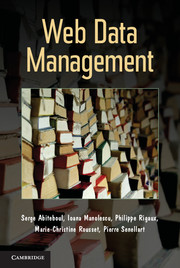Book contents
- Frontmatter
- Contents
- Introduction
- Part 1 Modeling Web Data
- Part 2 Web Data Semantics and Integration
- 7 Ontologies, RDF, and OWL
- 8 Querying Data Through Ontologies
- 9 Data Integration
- 10 Putting into Practice: Wrappers and Data Extraction with XSLT
- 11 Putting into Practice: Ontologies in Practice
- 12 Putting into Practice: Mashups with Yahoo! Pipes and XProc
- Part 3 Building Web Scale Applications
- Bibliography
- Index
10 - Putting into Practice: Wrappers and Data Extraction with XSLT
from Part 2 - Web Data Semantics and Integration
Published online by Cambridge University Press: 05 June 2012
- Frontmatter
- Contents
- Introduction
- Part 1 Modeling Web Data
- Part 2 Web Data Semantics and Integration
- 7 Ontologies, RDF, and OWL
- 8 Querying Data Through Ontologies
- 9 Data Integration
- 10 Putting into Practice: Wrappers and Data Extraction with XSLT
- 11 Putting into Practice: Ontologies in Practice
- 12 Putting into Practice: Mashups with Yahoo! Pipes and XProc
- Part 3 Building Web Scale Applications
- Bibliography
- Index
Summary
Besides languages to extract information such as XPath or XQuery, languages for transforming XML documents have been proposed. One of them, XSLT, is very popular. The goal of this PiP is to expose the reader to this aspect of XML and to languages based on tree-pattern rewriting. A presentation of XSLT is beyond the scope of this book. The reader can read the present PiP to get a feeling on standard tasks that are commonly performed with XSLT programs. Of course, realizing the project that is described requires a reasonable understanding of the language. Such an understanding can be obtained, for instance, from the companion Web site of the book, i.e., at http://webdam.inria.fr/Jorge/. More references on XSLT may be found there.
XSLT is an XML transformation language. Its principles are quite different from that of XQuery, although they may roughly serve the same purpose: accessing and manipulating XML content and producing an XML-formatted output. In practice, XQuery is used to extract pieces of information from XML documents, whereas XSLT is often used to restructure documents, typically for publishing them in different forms, different dialects. We show in the present PiP chapter how XSLT can serve to write simple “wrappers” for XML pages. This is taking us back to data integration. To integrate a number of data sources, the first step is typically to wrap them all into a uniform schema. Since most data source now export XML, the wrapping technique considered here can be used in a wide variety of contexts.
Information
- Type
- Chapter
- Information
- Web Data Management , pp. 231 - 235Publisher: Cambridge University PressPrint publication year: 2011
